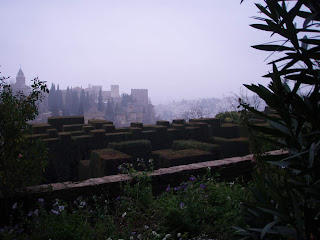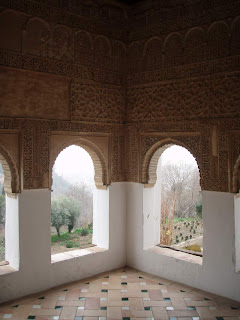 My day in Granada - what can i say, Alhambra is incredible, dream-like and totally worth a visit in one's lifetime - despite the crowds, despite the price, planning, ticketing etc - the spotlight of my trip, it even overdid Prado, and that is to say! I took over 200 pictures - and anyone can convert into being a photographer in this inspiring, geometry-filled place.
My day in Granada - what can i say, Alhambra is incredible, dream-like and totally worth a visit in one's lifetime - despite the crowds, despite the price, planning, ticketing etc - the spotlight of my trip, it even overdid Prado, and that is to say! I took over 200 pictures - and anyone can convert into being a photographer in this inspiring, geometry-filled place.I started the visit in the opposite direction of the crowd flow, and went first to the Generalife gardens (that's where the view on the Alhambra fortress in the morning mist above comes from), what used to serve as a summer house for the Sultan during the Islamic rain. Not much remains of the house, but the gardens are incredible. They were remodeled over time, like most of Alhambra, and that adds to their charm:
 The insides of the Ismail tower gives a taste of things to come in the other palaces. The interior decoration used to be split into two parts by the Islamic architects - lower part, called dado, with multi-colored tile decoration that would withstand numerous contacts with the outside world (not preserved to our times on the picture below) - like we do in the swimming pools -, and higher part with stucco, creating mocarabes, this incredible effect you can see on the picture below. Most of the decoration used calligraphic writing or colorful geometrical forms, color that mostly disappeared from the walls today. Thus poems about the Sultan commissioning the room run around the inside walls, telling us his prominence and glory.
The insides of the Ismail tower gives a taste of things to come in the other palaces. The interior decoration used to be split into two parts by the Islamic architects - lower part, called dado, with multi-colored tile decoration that would withstand numerous contacts with the outside world (not preserved to our times on the picture below) - like we do in the swimming pools -, and higher part with stucco, creating mocarabes, this incredible effect you can see on the picture below. Most of the decoration used calligraphic writing or colorful geometrical forms, color that mostly disappeared from the walls today. Thus poems about the Sultan commissioning the room run around the inside walls, telling us his prominence and glory.
I started the visit of Alhambra proper by the El Partal Palace, a perfect photo opportunity (nenuphar gardens recreated in the 19th century):

The Nasrid Palaces are the jewel of the place, and with tourist inflow their visit has been limited to 30 minutes, with time spots to reserve during each day. As there was no real control of when one gets out of the palaces, i stayed several hours taking pictures and falling in love with this place.
There are actually two palaces that create what is known as Nasrid Palaces, called that because of the last Nasrid dynasty of the sultans that ruled Islamic Granada before its final fall in 1492 and built the royal residency in the 14th century: Comares Palace and the Palace of Lions. Charles Quint appreciated them so much that he established his own residence in the old Arab palaces instead of using his newly built Collesium-like villa just behind them. Concerning the Charles Quint palace, someone called it a meteorite that landed by chance in the middle of Alhambra - and that is exactly what it felt like to me.
This is a picture of the entrance to the Comares Palaces, as visitors saw it when introduced there by the Sultan. The door on the right led to the harem and the living quarters, door on the left to the Myrtle court and the throne room.
 The court of the Myrtles, after the shadowed corridor following the left-side door above looks like this, with the immensely high (35 meters) throne room behind it:
The court of the Myrtles, after the shadowed corridor following the left-side door above looks like this, with the immensely high (35 meters) throne room behind it:
The decoration of the rooms alongside the court uses stucco and mocarabes to their fullest:

From the Myrtles court Charles Quint made a direct door to the second palace, what is now known as the Palace of the Lions. The picture below represents one side of the Lion's court, probably the most famous place in the Nasrid Palaces. Unfortunately the fountain was fenced off and lions were being restored, as well as the Kings' room, - which made me take 30 pictures less of the place, still incredibly beautiful:

Pictures by Juan Laurent of the same place, the Lion's court, but from the 19th century. His pictures did a lot to make Alhambra a popular tourist destination - and develop travel monument photography.

And the last thought - about cats - Granada is also somehow a city of cats. I saw so many of them around Dario river, in Alhambra and on the Albaicin that i couldn't believe it in the end. It does go with the town's mysterious and accommodating nature. And cats made me think about this painting by Dirk de Vos that i remember from Prado - the cats fight for dead prey. I cannot find it on the net as it's not that popular, it is rather peculiar.
The only thing i haven't seen is a granada tree with fruits on!
2 comments:
Hi Julia,
Congratulations for the report of Granada. I liked it. It also gave me the chance of seeing how Alambra looks like inside.We went there to spend our Easter holidays with the intention of doing some climbing. We had bad weather and cold during our staying in Andalucia, so, we didn´t climb as much as we wanted and we ended doing some tourism. We didn´t visit Alhambra because there were no tickets left. They told us that you have to book them in advance.I also liked Granada a lot. We met some nice people who live there now and we could understand Granada´s way of life. So many students, so many people passing by but few of them stay longer. We watched an incredible flamenco dancer dancing in the terrace where dancing in a small piece of wood while we were having some beers, also some gitanos singing with their guitars, some guys playing strange instruments. It was just great!You mentioned that Granada is a city of cats, I got the idea that Granada is a city of dogs. I saw so many dogs that seemed that many of them had no owners.We could watched and heard dogs fighting everywhere, thanks that we left our dog in the van.
About climbing, we went to Alfacar which is about 10 kilometers from Granada and Cahorros which is about 20 kilometers in the way to Sierra Nevada. Great sport routes!
It was a shame that I couldn´t meet you during your staying in Spain, I´m so busy this year...Maybe next time!
Kattagorri (Nerea)
Hey, Nerea, thx for the comment! Hopefully will see you next time in Spain.
Post a Comment